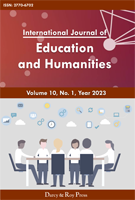Metaphorical Mapping of Spatial Prepositions IN, ON, AT Based on Image Schema Theory
DOI:
https://doi.org/10.54097/ijeh.v8i1.6941Keywords:
Image schema, Metaphorical mapping, Spatial prepositions.Abstract
Based on the theory of image schema, this paper constructs a metaphorical mapping mechanism of the spatial prepositions ‘IN, ON, and AT’ from spatial to non-spatial categories. It is found that they have differences in their basic spatial concepts that IN represents a three-dimensional concept of ‘body’, ON refers to a two-dimensional concept of ‘plane’, and AT shows a zero-dimensional concept of ‘point’. In addition, after metaphorical mapping, the spatial differences are equally applied to the non-spatial concepts of IN, ON, and AT.
Downloads
References
Chen, Y. H. (2005). Cognitive analysis of English prepositions and its application in teaching. (Unpublished doctoral dissertation). Chongqing Normal University, Chongqing, China.
Daniel, G. & Morrow. (1985). Prepositions and verb aspect in narrative understanding. San Diego: Journal of Memory and Language.
Fauconnier, G. (1985). Mental spaces. Cambridge, MA: MIT Press.
Gui, S. C. (2005). An overview of the use of English prepositions by Chinese learners and an analysis of English by Chinese learners based on CLEC corpora. Shanghai: Shanghai Foreign Language Education Press.
Herskovits, A. (1986). Language and spatial cognition: An interdisciplinary study of the prepositions in English. Cambridge: Cambridge University Press.
Holmqvist, K. (1993). Implementing cognitive semantics. Lund: Lund University Cognitive Studies.
Johnson, M. (1987). The body in the mind. Chicago: The University of Chicago Press.
Lakoff, G. (1987). Women, fire and dangerous things. Chicago: The University of Chicago Press.
Lakoff, G. & Johnson, M. (1980). Metaphors we live By. Chicago: The University of Chicago Press.
Lakoff, G., & Turner, M. (1989). More than cool reason: A field guide to poetic metaphor. Chicago: University of Chicago Press.
Lan, C. (2003). Spatial metaphor in Chinese and English from a cognitive perspective. Beijing: Foreign Language Teaching and Research Press
Langacker, R. W. (1987). Foundations of cognitive theory of metaphor. Stanford: Stanford University Press.
Lindstromberg, S. (2001). Preposition entries in UK monolingual learners' dictionaries: Problems and possible solutions. Applied Linguistics, 22, 79-103.
Liu, Z. (2003). The features of metaphorical mapping. Foreign Language Research,8-14.
More, J. (2014). Metaphor mapping: adjusting to your target - Science direct. Job Reconnaissance, 93-97.
Shepard, R. N., & Hurwitz, S. (1985). Upward direction, mental rotation, and discrimination of left and right turns in maps. In Visual Cognition, ed. Pinker, S. London: the MIT Press.
Shu, D. F. (2003). Metaphorical study. Shanghai: Shanghai Education Publishing House.
Song, X., & Su, C. (2021). Spatial preposition metaphor expansion based on cognitive load theory: A case study of spatial preposition in. Journal of Dalian Minzu University, 23 (6), 547-550.
Tyler, A., & Evans, V. (2003). The semantics of English prepositions: Embodied meaning and spatial experience. Cambridge: Cambridge University Press.
Wang, Y. (1994). At, on, and in with points, surfaces, and bodies. Knowledge of English, 10, 15-17.
Wu, J., & Wang, R. D. (2001). A contrastive study of spatial metaphor between English and Chinese. Shangdong Foreign Language Teaching, 3, 8-14.


















